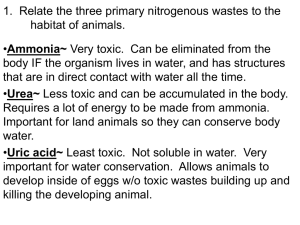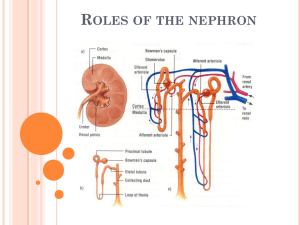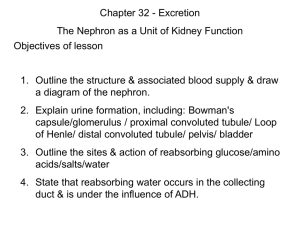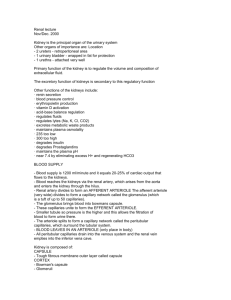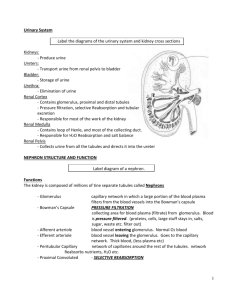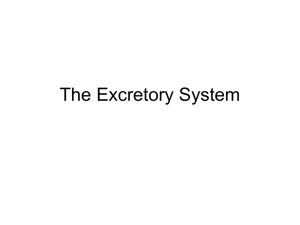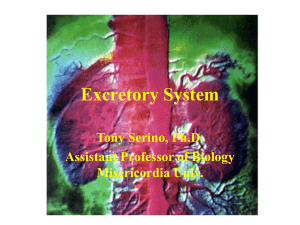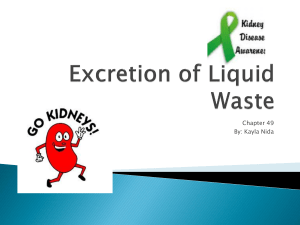Chapter 13 Power Point
advertisement
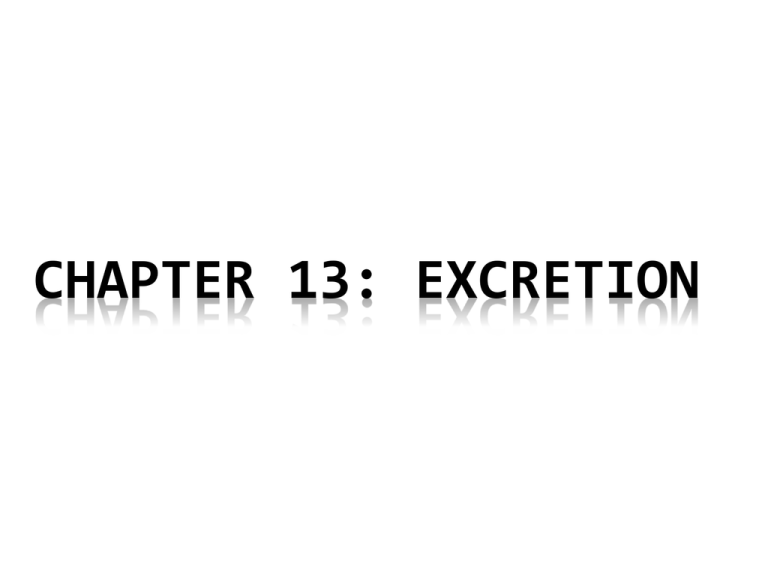
CHAPTER 13: EXCRETION EXCRETION Kidneys: •Filter blood of wastes & produces urine •Maintains water & salt balance •Maintains blood pH •Produces hormones Ureters: •Transports urine from kidney to bladder by peristalsis Bladder: •Stores urine until urination Urethra: •Transports urine from bladder out of body during urination Adrenal glands Urination = micturition reflex 1. Bladder fills with urine and stretches. 2. Stretch receptors send impulse to spinal cord and back as a reflex 3. Bladder contracts and internal sphincter relaxes 4. External sphincter is voluntary and you relax it during a convenient time to urinate http://highered.mcgraw-hill.com/sites/0072495855/student_view0/chapter27/animation__micturition_reflex.html Kidney Anatomy Renal Vein: Low in O2, high Renal Artery: High in O2, in CO2, lower than artery low in CO2, high in but still high in nutrients, nutrients, HIGH in wastes LOW in wastes Renal Pyramid Renal Medulla Renal Cortex Renal Pelvis Ureter Nephrons = kidney tubules for urine formation The renal artery carries blood high in wastes to the kidney. Filtration of the blood occurs at the nephron Wastes are excreted while nutrients are reabsorbed back into the blood Urine is formed and excreted from the kidney via the renal pelvis into the ureters Blood leaving the renal vein is low in wastes Nephron Anatomy & Urine Formation 1. Pressure Filtration - occurs at the glomerulus where blood is filtered. Only small molecules leave blood (plasma) but large molecules like the formed elements (RBCs, WBCs, platelets) and proteins are not filtered. 2. Reabsorption – where molecules are reabsorbed from the filtrate inside the tubule back into the blood capillary. 3. Excretion or Secretion – additional wastes, drugs and hydrogen ions (H+) can be excreted from blood into the nephron tubule to become a part of urine. Urine Formation 1. 2. Afferent Arteriole = high BP to bring wastes to glomerulus Pressure filtration at glomerulus to push small molecules out of blood (formed elements and proteins not filtered) 3. Filtrate enters glomerular capsule 4. At the proximal convoluted tubule reabsorption of nutrients (glucose, amino acids), water, salt – both actively & passively; PCT has microvilli and mitochondria to help with maximal transport of molecules across nephron Afferent Arteriole Glomerulus Efferent Arteriole Filtrate goes down into the loop of the nephron where it is hypertonic outside the tubule. This causes water to be reabsorbed along the descending limb of the loop 6. Salt (NaCl or Na+) is reabsorbed along the ascending limb of the loop. This is what causes the medulla to become hypertonic drawing the water out of the tubule by osmosis at the descending limb. Note: water reabsorption also occurs at the collecting duct due to the hypertonic medulla 5. 7. The filtrate travels up into the renal cortex again into the distal convoluted tubule where additional wastes like creatinine is excreted. Also drugs and Hydrogen ions. To maintain pH balance, H+ is excreted and HCO3- is reabsorbed. The H+ is buffered by ammonia in the tubule and urine 8. The filtrate from many nephrons is now collected by the collecting duct. Since is passes through the renal medulla again, additional water is reabsorbed as it passes through this hypertonic area. This concentrates the urine. Note: some urea may be reabsorbed due to the concentration gradient. Summary Hormones During dehydration or low water concentration in the blood, the hypothalamus produces Anti-Diuretic Hormone (ADH). ADH is secreted out the posterior pituitary gland into the blood to act on the kidney ADH acts on the collecting ducts of the nephrons to increase water reabsorption This increases blood volume and water concentration which is detected by the hypothalamus Negative feedback results and the hypothalamus decreases ADH production Urine is also more concentrated due to less water content in urine Aldosterone When there is low BP due to low blood volume, a specialized group of cells in the kidney called the juxtaglomerular apparatus detects this low BP and secretes renin into the blood Renin causes the conversion of Angiotensinogen (a plasma protein from the liver) to Angiotensin I Angiotensin I is converted to Angiotensin II in the lungs Angiotensin II causes vasoconstriction to increase BP & it acts on the adrenal glands to secrete aldosterone Aldosterone is secreted from the adrenal cortex It causes an increase in salt (NaCl or Na+) reabsorption at the nephron This results in an increase in water reabsorption resulting in an increase in blood volume and blood pressure Since increased salt reabsorption causes an increasingly hypertonic medulla resulting in an increased water reabsorption along the descending limb and the collecting ducts occurs Structure/Molecule Function Glomerulus/Glomerular Capsule Site of pressure filtration Glucose & amino acids These molecules are completely reabsorbed at the PCT Collecting Duct (& DCT) ADH acts here to increase water reabsorption Descending limb of loop The part is impermeable to salt reabsorption Hydrogen ion / H+ When blood pH is low, there is an increase in excretion of this molecule Salt/NaCl/Na+ Reabsorption of this molecule creates a hypertonic medulla Collecting Duct The is the last place in the nephron that water is reabsorbed Adrenal Gland (adrenal cortex is more specific) Aldosterone is secreted from this gland Aldosterone This hormone causes increased salt reabsorption Structure/Molecule Function PCT Site of glucose reabsorption Microvilli Increases surface area for transport of molecules through nephron Urea & Uric Acid This waste is filtered out of blood at the glomerulus Renin When BP drops, the nephron produces this hormone DCT Blood pH is regulated by transport of molecules at this part of the nephron Water/H2O This molecule is reabsorbed at the PCT, loop, and collecting duct Renal Pelvis This part of the kidney collects all of the urine from the nephrons Bladder This structure help to store urine Ureter(s) Peristalsis along this tube transports urine to the bladder Label all molecules with direction of transport in the nephron A B C D 2 3 4 A B Function Contains lowest amount of wastes in blood Reabsorption of nutrients Pressure filtration is due to high BP Collects small molecules from blood Water reabsorption and transport of urine to renal pelvis Salt (Na+) reabsorption to make a hypertonic medulla Only permeable to water Acid base balance and drug excretion Delivers blood high in wastes towards kidney Reabsorbed molecules re-enter blood here

